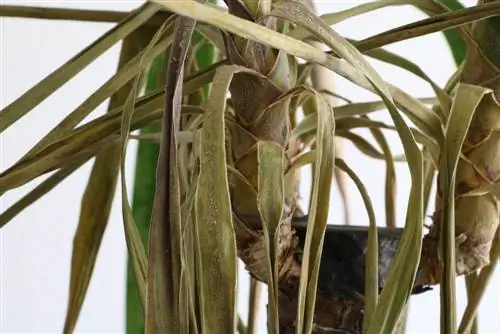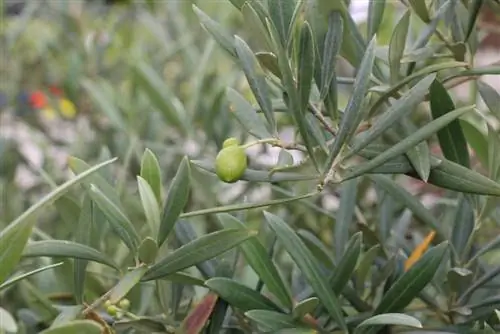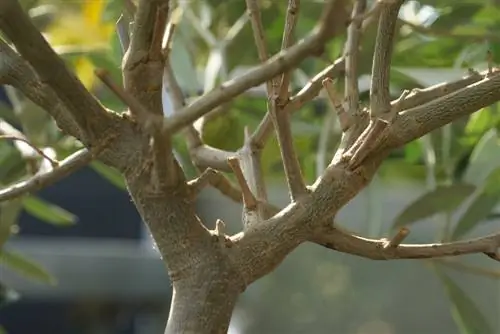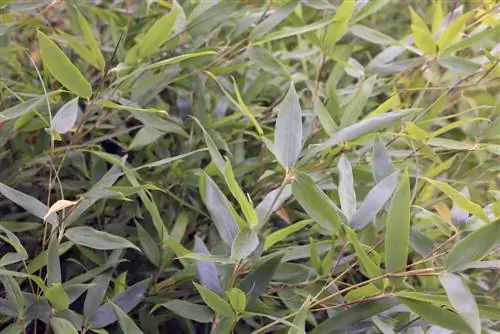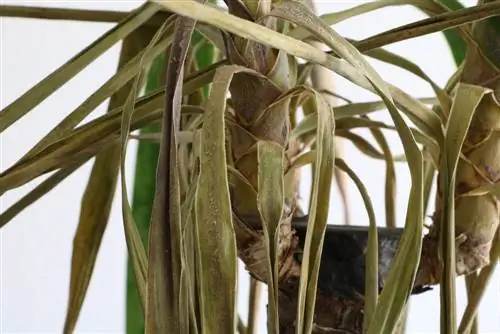- Author admin [email protected].
- Public 2023-12-17 03:39.
- Last modified 2025-01-24 12:45.
The Yucca palm is considered a guarantee for easy-care indoor greenery that requires little attention. The evergreen plant with the palm-like silhouette only lives up to this image if the requirements for professional cultivation are met. The light and temperature conditions at the location are just as relevant as balanced watering and fertilization. Where the conditions are not right, the palm lily presents itself with yellow leaves and brown tips. In order to uncover the cause of the damage, you cannot avoid a detailed analysis. We have put together common causes with suggestions for a solution for you here.
Lack of light
Solution: Move to a bright location
The majority of palm lily species are native to the sun-drenched regions of Mexico. Their shapely sword leaves only retain their rich green color if they remain in a bright, sunny location. A yucca palm should be exposed to sunlight at least in the morning or evening. Where this is not the case, the leaves turn yellow during the dark season at the latest. Therefore, put the lighting conditions to the test and, if in doubt, move the sun-hungry plant to a place on the south, west or east window, with shading from bright sunlight at midday.
drought
Solution: Dip and from now on water after finger test
For a yucca palm to meet expectations as a dominant houseplant, a balanced water balance sets the course. If the evergreen plant suffers from a lack of water, this results in growth depression, during which the tips of the leaves turn brown. If the drought continues, all of the foliage will die. As an immediate measure, the root ball is dipped. This is how it works:
- Dip the dried root ball into a bucket of lime-free water
- Soak until no more air bubbles appear
- Allow the water to drain well before placing the bucket back in the saucer
From this point on, please check the moisture content of the soil every few days using a thumb test. If the top 2-3 cm of the substrate feels dry, the palm lily is watered. This is more common in summer as the plant is in the growth phase. In winter, the watering intervals are extended to up to 14 days.
Waterlogging
Solution: Repot and water more sparingly
Due to their South American origin, palm lilies are designed to conserve water during dry times. However, the agave family is not familiar with constantly wet soil. As a result of excessive watering and the resulting waterlogging, the roots become soft and rotten. As a result, the supply of the sword leaves stops and the leaves turn yellow. If you notice that the earth is dripping wet, urgent action is required. The yucca palm can only be saved if you repot the plant into fresh substrate as soon as possible. If the pot is completely rooted, please use a container that is 3 to 5 cm larger. Otherwise, you can use the previous pot again after thorough cleaning. Here's how to do it:
- Unpot the yucca palm and completely remove the substrate
- Cut out softened, rotten roots with a sharp knife
- Spread pottery shards or expanded clay in the bucket above the bottom opening as drainage
- Pour in a first layer of fresh plant soil
- Plant the root ball as deep as before
You can effectively prevent renewed waterlogging by using a loose, permeable substrate. Ideally, you mix the various components together yourself. A mix of 5 parts standard soil, 4 parts clay-containing garden soil, 1 part quartz sand and 1 part perlite respiration flakes has proven to be excellent for palm lilies. Check the finished substrate with an indicator strip for an ideal pH value of 6.0 to 7.0. Adding peat or ericaceous soil can lower a value that is too high.
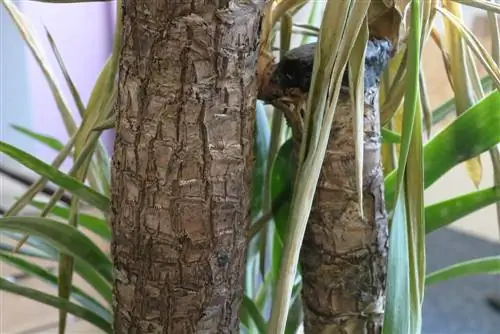
Tip:
If the base of the trunk is softened due to waterlogging, the upper parts of the plant are no longer supplied with water and nutrients. To save the yucca palm, cut off the he althy part and let it root in a pot with potting soil.
Sunburn
Solution: Changing location or shading at lunchtime
If the unfiltered rays of the midday sun hit a yucca palm in summer, the plant suffers sunburn. The visible symptom is leaves that have turned light yellow. This damage is particularly noticeable if the palm lily has not been gradually accustomed to direct sunlight in spring and summer. Since sunburn is not a disease, there is a good chance that the palm lily will regenerate again. You can either change location or provide light shading during midday. To prevent yellow leaves due to sunburn, gradual acclimatization works by hardening the plant in a partially shaded location for 8 to 10 days before moving it to a place in full sunshine.
Incorrect wintering
Solution: Overwinter appropriately
The diverse genus of palm lilies includes more than 50 species with numerous subspecies, sections and hybrids. Yucca palms that are completely hardy can be found here, as well as specimens that are sensitive to frost. None of them like a warm winter. If yellow leaves with brown tips appear over the course of the winter, the site conditions do not match the plant's wishes. This is how you properly guide a yucca through the cold season:
- Spend in a bright, cool location with temperatures between 10 and 12 degrees Celsius, maximum 15 degrees Celsius
- Watering sparingly with soft water
- Do not fertilize from November to February
From the beginning of March, the plant gradually gets used to higher temperatures and the sun. An abrupt change from the winter quarters to the warm south window should be avoided because the plant could also react to this climate shock with yellow leaves.
Nutrient Deficiency
Solution: Fertilize every 14 days during the growing season
In the limited substrate volume of the pot, a yucca palm only has a limited amount of nutrients available. Proportionate to the progress of growth, the meager supplies are quickly used up. If the palm lily suffers from a lack of nutrients, it remains in its current size and the leaves lose their green color. If you can identify this cause as the trigger for yellow leaves, please change the nutrient supply to this rhythm:
- Fertilize every 14 days from May to October
- Add a liquid fertilizer for green plants to the irrigation water
- Do not fertilize from November to April
So that the s alts contained in the fertilizer do not cause root damage, water with clear water before and after.
Tip:
There is no reason to be alarmed if a leaf on your yucca palm turns yellow every now and then. Even evergreen leaves eventually expire, turn yellow and die to make room for fresh green.
lime surplus
Solution: Watering with rainwater or decalcified tap water
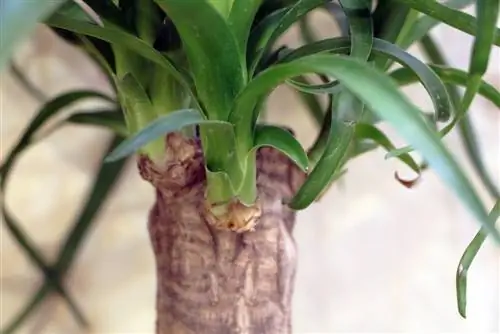
If you were able to rule out all the causes mentioned above during the analysis, the water quality is probably responsible for yellow leaves on your yucca palm. Since the plants require a slightly acidic to neutral pH value of 6.0 to 7.0, lime-free water should primarily be used for watering. Ideally it is collected, filtered rainwater. As an alternative, you can use stale or decalcified tap water. If a palm lily is supplied predominantly with hard water, the lime content in the substrate accumulates. As a result, important nutrients are stored and no longer transported to the leaves. The result is yellowed leaves with green leaf veins.
Fungal infections, such as leaf spot or others
Solution: Fungicides
Palm lilies that spend part of the year outdoors are particularly at risk of disease. A summer with warm, humid weather promotes infestation with fungal spores. The infection of the widespread leaf spot disease can be recognized by brown spots that spread from the tips over the leaves. Other fungal pathogens can be recognized by a mealy-gray coating, such as powdery mildew. This spreads further and deprives the foliage of its livelihood, so that it turns yellow and dies. The first step is to remove the infected leaves to prevent further spread. You can then consider using a fungicide from a specialist retailer.
Spider mites
Solution: Fight with home remedies
If a yucca palm is infested with spider mites, the leaves take on a yellow color and begin to die from the tip. If you suspect the pests, please examine the undersides of the leaves in particular. The tiny insects like to settle here. Measuring 0.25 to 0.8 mm in size, a keen eye or magnifying glass is required to identify the green-white, yellow or red pests. For effective control, a chemical insecticide is not necessarily required in the early infestation stage. With these home remedies you can get rid of pests in an environmentally friendly way:
- In the first step, pack the root ball well to give the plant a thorough shower
- Then wipe the affected leaves with a cloth soaked in alcohol
- Isolate the palm lily from other plants and spray it with lime-free water every 1-2 days
- Set up a humidifier in the quarantine room, as a humidity of more than 50 percent repels spider mites
If there is high infestation pressure, we recommend using a he alth and environmentally friendly insecticide based on rapeseed oil. Such preparations are applied to the leaves of the plagued palm lily in the evening because they impair the natural protective layer for a few hours. If sunlight hits the leaves during this time, they could wither. By the next morning, the active ingredients have broken down so that the leaves can withstand the sun again.
Conclusion
If a palm lily has yellow leaves, the site conditions are not right or the care is not going as planned. So that you can quickly find the solution to the problem, we have compiled common causes and suggested solutions for you here. It is usually a location that is too dark or too bright, which is responsible for yellow leaves with brown tips. Incorrect watering and fertilization also come into focus, followed by unfavorable wintering as well as diseases and pests.

